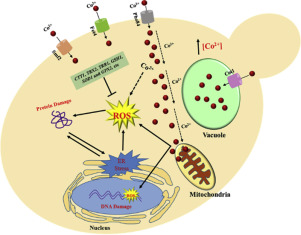当前位置:
X-MOL 学术
›
BBA Gen. Subj.
›
论文详情
Our official English website, www.x-mol.net, welcomes your feedback! (Note: you will need to create a separate account there.)
Genetic analysis of oxidative and endoplasmic reticulum stress responses induced by cobalt toxicity in budding yeast.
Biochimica et Biophysica Acta (BBA) - General Subjects ( IF 3 ) Pub Date : 2020-01-03 , DOI: 10.1016/j.bbagen.2020.129516 Yun-Ying Zhao 1 , Chun-Lei Cao 1 , Ying-Li Liu 2 , Jing Wang 2 , Shi-Yun Li 3 , Jie Li 4 , Yu Deng 5
Biochimica et Biophysica Acta (BBA) - General Subjects ( IF 3 ) Pub Date : 2020-01-03 , DOI: 10.1016/j.bbagen.2020.129516 Yun-Ying Zhao 1 , Chun-Lei Cao 1 , Ying-Li Liu 2 , Jing Wang 2 , Shi-Yun Li 3 , Jie Li 4 , Yu Deng 5
Affiliation

|
BACKGROUND
Cobalt is an important metal cofactor of many living cells. However, excessive cobalt is toxic and can cause cell death and even several diseases in humans. Saccharomyces cerevisiae is a useful tool for studying metal homeostasis and many of the genes and pathways are highly conserved in higher eukaryotes including humans.
METHODS
The intracellular cobalt and reactive oxygen species (ROS) levels were measured by an atomic absorption spectrometer and DHE staining method, respectively. The expression of genes involved in scavenging oxidative stress was tested by qPCR method, while the expression of UPRE-lacZ report gene was analyzed via β-galactosidase activity assay.
RESULTS
Using a genome-scale genetic screen, 153 cobalt-sensitive and 37 cobalt-tolerant gene deletion mutants were identified from Saccharomyces cerevisiae. We showed that 101 of the cobalt-sensitive mutants accumulated higher intracellular cobalt compared to wild-type. The intracellular ROS levels in 112 of the mutants were induced by cobalt, which might be caused by the decreased expression of genes involved in scavenging oxidative stress in response to cobalt. Moreover, more than one-third of the cobalt-sensitive mutants were also sensitive to tunicamycin, and cobalt stress might induce the unfolded protein response (UPR) through serine/threonine kinase and endoribonuclease Ire1.
CONCLUSIONS
This study reinforced the fact that cobalt toxicity might be due to the high intracellular cobalt and ROS levels, and the endoplasmic reticulum stress responses induced by cobalt.
GENERAL SIGNIFICANCE
Elucidating the toxicity mechanisms of cobalt stress response will help reveal new routes for the treatment of the diseases induced by cobalt.
中文翻译:

钴毒性对发芽酵母中氧化和内质网应激反应的遗传分析。
背景技术钴是许多活细胞的重要金属辅因子。但是,过量的钴是有毒的,会导致细胞死亡,甚至导致人类多种疾病。酿酒酵母(Saccharomyces cerevisiae)是研究金属稳态的有用工具,许多基因和途径在包括人在内的高等真核生物中都高度保守。方法采用原子吸收光谱仪和DHE染色法分别测定细胞内钴和活性氧(ROS)水平。通过qPCR方法检测清除氧化应激的基因的表达,并通过β-半乳糖苷酶活性分析分析UPRE-lacZ报告基因的表达。结果使用基因组规模的遗传筛选,从酿酒酵母中鉴定出153个对钴敏感的基因和37个对钴耐受的基因缺失突变体。我们显示,与野生型相比,101种对钴敏感的突变体积累了更高的细胞内钴。钴诱导了112个突变体的细胞内ROS水平,这可能是由于清除钴后氧化应激所涉及的基因表达降低所致。此外,超过三分之一的钴敏感突变体也对衣霉素敏感,钴胁迫可能通过丝氨酸/苏氨酸激酶和核糖核酸内切酶Ire1诱导未折叠的蛋白反应(UPR)。结论这项研究进一步证实了钴的毒性可能是由于细胞内高的钴和ROS水平以及钴诱导的内质网应激反应。
更新日期:2020-01-04
中文翻译:

钴毒性对发芽酵母中氧化和内质网应激反应的遗传分析。
背景技术钴是许多活细胞的重要金属辅因子。但是,过量的钴是有毒的,会导致细胞死亡,甚至导致人类多种疾病。酿酒酵母(Saccharomyces cerevisiae)是研究金属稳态的有用工具,许多基因和途径在包括人在内的高等真核生物中都高度保守。方法采用原子吸收光谱仪和DHE染色法分别测定细胞内钴和活性氧(ROS)水平。通过qPCR方法检测清除氧化应激的基因的表达,并通过β-半乳糖苷酶活性分析分析UPRE-lacZ报告基因的表达。结果使用基因组规模的遗传筛选,从酿酒酵母中鉴定出153个对钴敏感的基因和37个对钴耐受的基因缺失突变体。我们显示,与野生型相比,101种对钴敏感的突变体积累了更高的细胞内钴。钴诱导了112个突变体的细胞内ROS水平,这可能是由于清除钴后氧化应激所涉及的基因表达降低所致。此外,超过三分之一的钴敏感突变体也对衣霉素敏感,钴胁迫可能通过丝氨酸/苏氨酸激酶和核糖核酸内切酶Ire1诱导未折叠的蛋白反应(UPR)。结论这项研究进一步证实了钴的毒性可能是由于细胞内高的钴和ROS水平以及钴诱导的内质网应激反应。


























 京公网安备 11010802027423号
京公网安备 11010802027423号